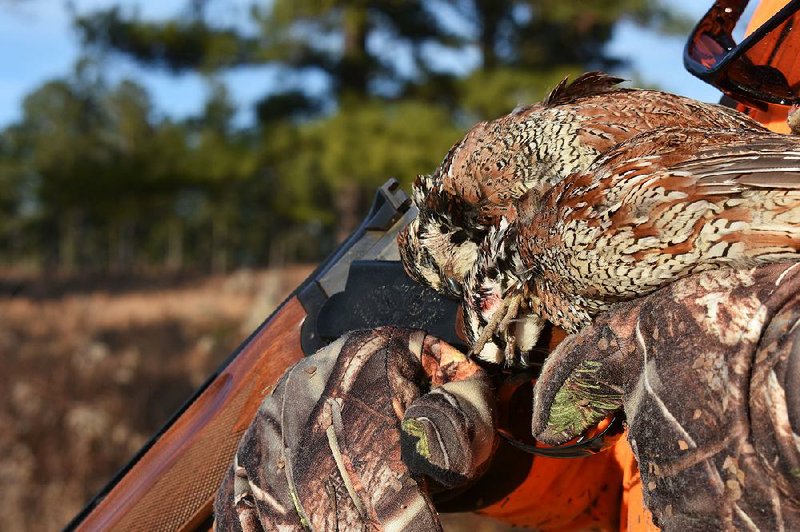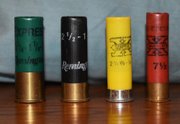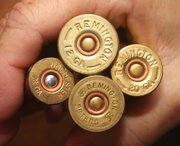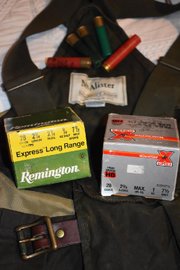Along with a superior quail hunt, my recent trip to Georgia renewed my dormant love affair with an old flame, the 28-gauge shotgun.
The 28-gauge is in no way deficient. It just doesn't really apply to the hunting we do in Arkansas. This is duck hunting country, so ours is a 12-gauge state. We also like our twelves big and brawny. Somewhere we got the idea that 23/4-inch 12-gauge shells don't kill game anymore. We prefer 3-inch magnums, and some of us even prefer 31/2-inch magnums, which launch 10-gauge payloads from overbored 12-gauge tubes.
Many of us who don't use 31/2-inch shells insist on having 12-gauge shotguns with 31/2-inch chambers because you never know when you might need one.
I mostly use a 16-gauge these days, and it's enough. Joe Morgan of Little Rock, a member of the Arkansas Game and Fish Commission, hunts only with a 20-gauge.
Commissioner Bobby Martin of Bentonville hunts with a .410-bore, including ducks. Martin's gun is art, a vintage Model 42 Winchester with jaw-dropping figures in the stock and gold engraved game scenes in the receiver.
Those in the artillery division of the shotgun world wrongly say that the .410-bore and 28-gauge are good guns for children and beginners because of their light payloads and light recoil.
The opposite is true. They are unsuited for beginners for those very reasons. Their light payloads expose, not mask, a gunner's deficiencies. A 2 3/4-inch 12-gauge shell with 11/8-ounces of No. 7 1/2 lead shot contains, on average, 394 pellets, or 350 pellets for a 1-ounce target load.
The standard field load for 28-gauge is 3/4 ounces. It contains 262 No. 7 1/2 lead pellets.
Squeezing that 3/4-ounce load through an improved cylinder tube in a 28-gauge throws a tight, dense pattern compared to that of a 12-gauge, hence the 28-gauge's reputation for mythical lethality.
If you shoot at a bobwhite racing away at full speed with a 28-gauge, you'll hit it with the full pattern, or you will miss. Hence that giant puff of feathers in the photo that ran in last week's column about the quail hunt. That hunter used a 3/4-ounce load of No. 7 1/2 lead in a Beretta Silver Pigeon 28-gauge.
With a comparatively wide 12-gauge pattern, you can be off a little and still clip a bird with a few pellets at the edges of the pattern.
The 28-gauge and .410 bore tilt the advantage to the bird, which is why they are also called "gentlemen's" guns. For that reason, our host in Georgia does not allow 12-gauge shotguns on his property. He will tolerate 20-gauge, but he makes it clear that he prefers 28-gauge and .410 bore.
As a youth and young adult in the 1970s and 80s, I hunted exclusively with a 20-gauge. You could hunt waterfowl with lead shot back then, and a 20-gauge was more than adequate. Its lethality for waterfowl suffered greatly from the poor quality of early steel shot loads, so in the late 80s I switched to a Smith & Wesson Model 1000 12-gauge. My brother had one, and I emulated my brother closely in many respects. He had a Chevelle Super Sport as a teenager, so I had to have one, too. I got a Suzuki four-wheeler because he had one, and so on.
Curiously, I switched to 28-gauge during my time in Oklahoma in the late 1990s. That was quail country, and I learned to bird hunt under the wing of Steve DeMaso, the quail biologist for the Oklahoma Department of Wildlife Conservation. DeMaso and Mike O'Meilia, the ODWC's waterfowl biologist, also taught me to shoot skeet and sporting clays. I learned the art of shotgunning at the Oklahoma Trap Association Shooting Park in El Reno and at Silverleaf Gun Club near Guthrie, Okla.
Learning to reload your own shells is the natural progression for a high-volume competitive target shooter. Extensive experimentation led me to one superlative load, Winchester AA or Remington STS hulls with 3/4-ounce of 71/2 lead powered by 14.1 grains of Alliant Green Dot, a WAA28 or Remington PT28 wad and a W209 primer. I have inconsistent success with Federal hulls, which often fail to hold a crimp.
My first 28-gauge was a Ruger Red Label over/under. I hated it, and it hated me. Sometimes it would fire, and sometimes it wouldn't. The "wouldn't" times were usually on wild pheasants and quail, as witnessed several times by Warren Montague of Waldron.
I switched to an unlikely candidate, a Browning BPS. I shot it very well, and I learned that tearing up a clays course with a pump gun intimidates opponents that don't know you.
For several years I hunted with a 28-gauge Baikal side-by-side. That was a cheap Russian gun licensed by Remington, but it handled exceptionally well.
My "gentleman's" gun is an SKB 505 over/under. It fits like a custom double, and its subtle elegance mingled well in Georgia among high-dollar Berettas and higher-dollar doubles with double Italian names. The Benelli Ethos 28-gauge autoloader that one of our group used mingled quite well in that company, too.
New Year's weekend reminded how much fun sub-gauge shotgunning is, and how much it means to shoot one well.
The sporting life always comes full circle. My 28-gauge MEC Sizemaster is bolted back to my bench after a 16-year absence, and I have a new supply of Green Dot to fill many bags of empty hulls.
Sports on 01/14/2018




